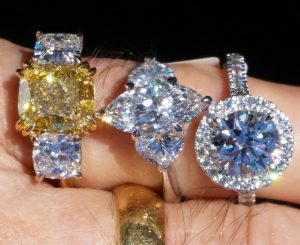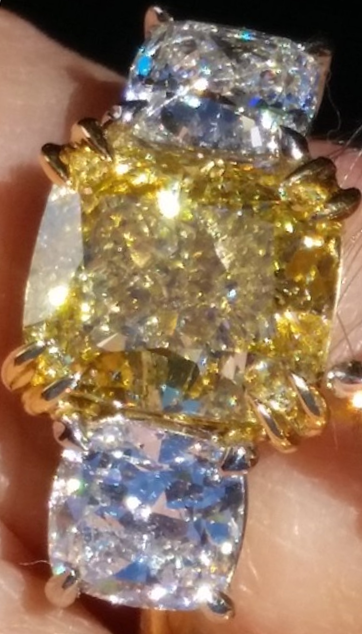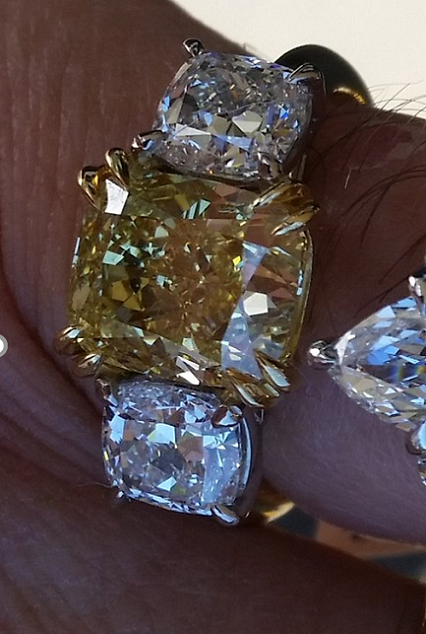Caring for your Jewellery while abroad
Heading to the Mediterranean this season? While you soak up the sun, make sure your diamonds are just as radiant when...
The best cut diamond appears darkest when viewed in direct sunlight. That doesn’t seem to make sense, does it? Read on to learn why.
The sun is very bright very small pin-point bright light. It appears larger to us because of glare and atmospheric magnification at sunrise and sunset. An ideal cut diamond shows only a few intensely bright flashes in direct sunlight. A diamond that actually looks good in sunlight splits those few flashes up into ten or twenty smaller sparkles. We call those diamonds ‘crushed ice’ because they appear to have many more facets than the perfect round brilliant cut diamond. They never look as bright as an ideal cut diamond in any other type of light.
Those bright sparkles mean you are looking directly at the sun, causing your pupils to contract. Contracted pupils make the rest of the diamond appear dark. Looking directly at the sun is bad for your eyes so our pupils contract as self-protection.
More bright sparkles means worse cut! Viewing a spotlessly clean ideal cut round brilliant cut diamond in direct sunlight (please wear sunglasses) with one eye closed you should see only 3 to 5 bright flashes. Hold the diamond and your position very still. The more flashes you see from each different position the worse the diamond cut quality. With both eyes open you will see twice as many bright facets, except where one flash is so broad that both eyes see it emanating from the very same facet.
GIA give round brilliant diamonds a cut grade, but they don’t actually grade the stones light performance. The grading is based on the diamond’s parameters (GIA’s can’t grade other shapes than round because there are too many variables for their proportion based approach). In theory, a black diamond could receive GIA’s top XXX cut quality. If a diamond is not totally crystal clear and transparent GIA can still give it the top cut grade. Holloway diamonds™ have been screened to avoid milky haziness.
Many diamonds have reduced transparency because they have clouds or internal graining. GIA grade those features as clarity characteristics without any mention on a grading report or cert that the diamond does not sparkle as it should. At Holloway Diamonds we believe that’s unfair to consumers. A diamond with an excellent cut grade should never be a poor light performer!

IMAGE I – Illustrates 5 different cut styles seen in direct sunlight. As you can see the Ideal Round Cut Diamond on the right appears to be the darkest amongst the 3 diamond rings. The darker a diamond appears to be under direct sunlight, the better and brighter the diamond will appear in every other type of lighting.

IMAGE II – In shaded daylight, the round diamond is the brightest. Centre Stone-Left- Cushion Cut; Centre Stone-Middle- Marquise-Cut; Centre Stone-Right- Ideal Round Cut Diamonds under Shade Lighting.
IMAGE II illustrates the same diamond rings as shown in IMAGE I. The rings have been moved into the shadow cast by Garry Holloway’s body, a shaded lighting environment but still outside on a cloudless bright summers’ day. As you can see the Ideal Round Cut diamond now looks to be the brightest.
The best lighting to view the brightness or brilliance of a diamond is under leafy tree and even better on a bright but cloudy day. The light filtering through the leaves is creates hundreds of diffused tiny spot lights to illuminate the diamond. The exact opposite of direct sunlight! Garry Holloway’s video of a 5 Carat D Colour Strong Blue Fluorescent Brilliant Round Cut diamond is an excellent demonstration.
Under LED or spot Lighting typically found in shopping centres and big box stores with high ceilings is another good place to see the brilliance, fire and scintillation of the diamond. High-light performing diamonds such as the Holloway diamonds™ used in Garry Holloway’s video have large bold flashes where the 8 symmetrical arrows flare up intensely. This is what makes a diamond eye-catching.
As mentioned there is a misconception amongst consumers that a GIA (Gemological Institute of America) certified Triple Excellent Cut Quality Brilliant Round Cut diamond or XXX cut quality is the best cut quality diamond. GIA’s grading of colour and clarity is good enough for a Holloway diamond™ but Holloway light performance is in another league. A Holloway diamond™ proportions are defined by Holloway Cut Adviser or HCA (link) and sadly around 80% of XXX diamonds fail the HCA test. GIA certified diamonds that received their Excellent symmetry grade more often than not also fail on Ideal-Scope symmetry analysis.
Every Holloway diamond™ has been examined with and passed quality control for light performance and symmetry with an Ideal-Scope (or for other cut shapes, with an ASET scope). The Ideal-Scope will help reject diamonds with poor brilliance and scintillation.
Poor light performing diamonds are being sold to uninformed consumers every day. In fact, the majority of diamonds that are in retail stores and sold online are those that you wouldn’t buy once you’ve assessed it with an Ideal-scope. So if you’re planning to buy a diamond rings, engagement rings from your local jewellery store, it’s a good idea to invest in an Ideal-Scope. When shopping online you can ask for an Ideal-Scope photo. What you’re looking for in a well-cut diamond are dark symmetrical arrows with the rest of the diamond being bright red or pink with little or no white.
Brilliance is the comparative measure of a diamonds ability to return light from the surroundings to anyone looking at the diamond.
Scintillation is how the light emerging from the diamond plays and flashes giving the diamond its sparkle as the diamond is moved. The sparkle can be bright white or coloured firey flashes.
Fire of the stone is how the facets refract and disperse the light into the colours of the rainbow. As you move the diamond, you see flashes of rainbow colours bursting from within the diamond; blues and reds predominate.
Consider the fancy yellow coloured cushion cut diamond in Table III. It is the brightest under direct sunlight and the dullest in shaded daylight. This ‘crushed ice’ style of diamond cut does not show much brilliance at all but is exceptional at ‘trapping’ light inside a diamond, therefore, enhancing its colour. If this diamond had been cut into an ideal round cut it would be a paler yellow and less attractive.

Yellow cushion cut diamond under direct sunlight

Yellow cushion cut diamond under shade lighting
Table III: Fancy colour shaped diamond under Shade Lighting and Direct Sunlight.
Another reason why your diamond may not appear as bright as it should be is due to certain types of tiny scattered inclusions called ‘çlouds’ and ‘internal graining’. These inclusions can cause your diamond to have a dull milky appearance and this is especially so if the diamond is fluorescent.
If the entire diamond has thousands of microscopic inclusions, too small to see with a 10X loupe, it can cause your diamond to appear milky, this can happen on VS to SI Clarity grades. In the following blog, we discuss hazy milky diamonds that result from fluorescence (see next week’s blog). Retailers often classify these diamonds as ‘eye-clean’ as these inclusions aren’t visible to the naked eye. These inclusions are not even evident even when looked at using a 10x magnifying loupe. They usually require magnification of 100X or more to see the individual inclusions. In sunlight, those inclusions can also stop the light from travelling through and emerging from the diamond.
When the sun is very bright and the rest of the sky is blue, the body colour of a well cut diamond will be returning the blue from the sky. Many consumers have been led to believe that this is a result of fluorescence in a diamond, however the blue effect is often identical in fluorescent and non fluorescent diamonds!
The two reasons why some diamonds appear darker in sunlight is due to High Light Performance. The better the cut the darker a diamond will appear under direct sunlight. If you view the diamond outdoors then it is advised to shade the direct sunlight with your body, or better still, view it under a broad leaf tree. This is when you see the combined brilliance and fiery coloured sparkles most diamond lovers like to see. There are a lot of poor light performing diamonds being sold to uninformed consumers every day. One way to sort the wheat from the chaff is to buy the Beginner Ideal-scope Kit when shopping for diamonds. Or drop into a Holloway store and we will give you a free Ideal-Scope card with instructions. Read next week’s blog to discover why the Ideal Cut Round Diamond appears blue. The cause is not the level of fluorescence of the diamond in strong Ultra Violet sunlight.
For more information on diamonds and cuts click here
Heading to the Mediterranean this season? While you soak up the sun, make sure your diamonds are just as radiant when...
When it comes to purchasing an engagement ring, the diamond isn’t the only star of the show. The setting style can...
Investing in gold jewellery is a time-honoured tradition that continues to shine in 2025. Gold has been a reliable...